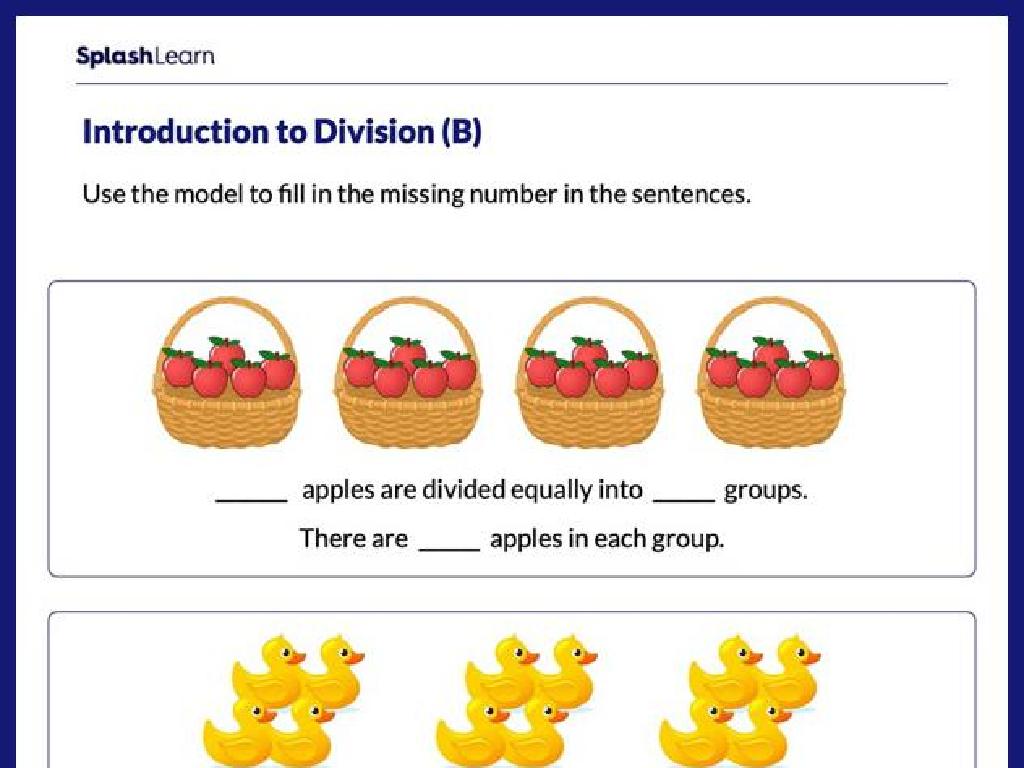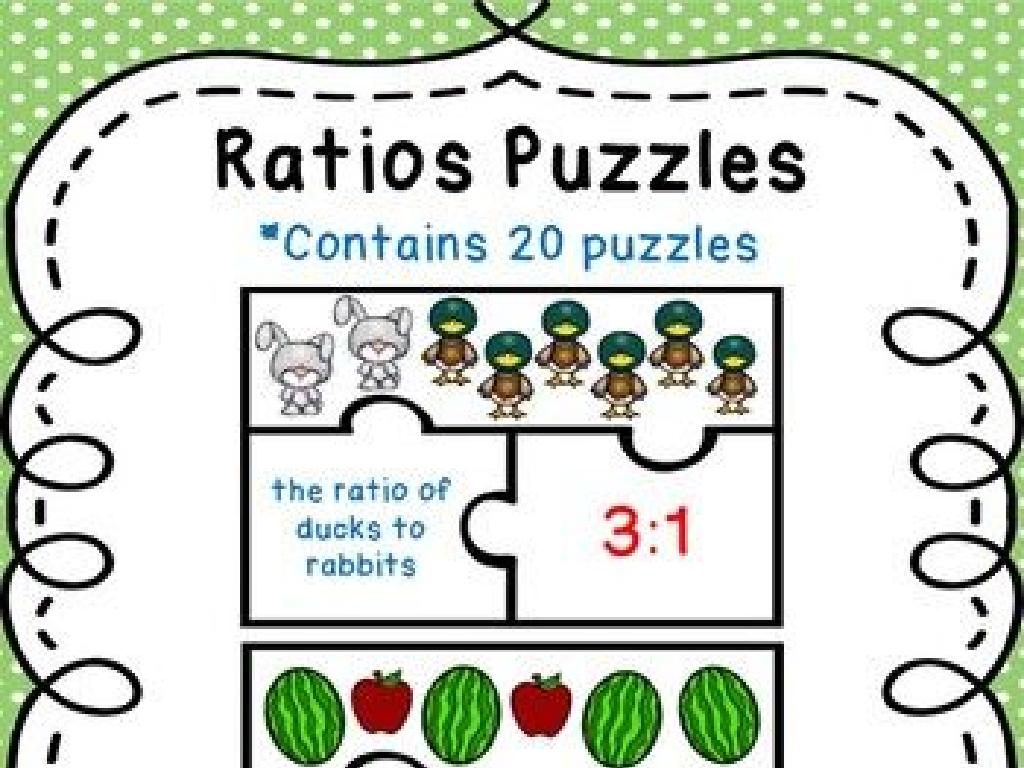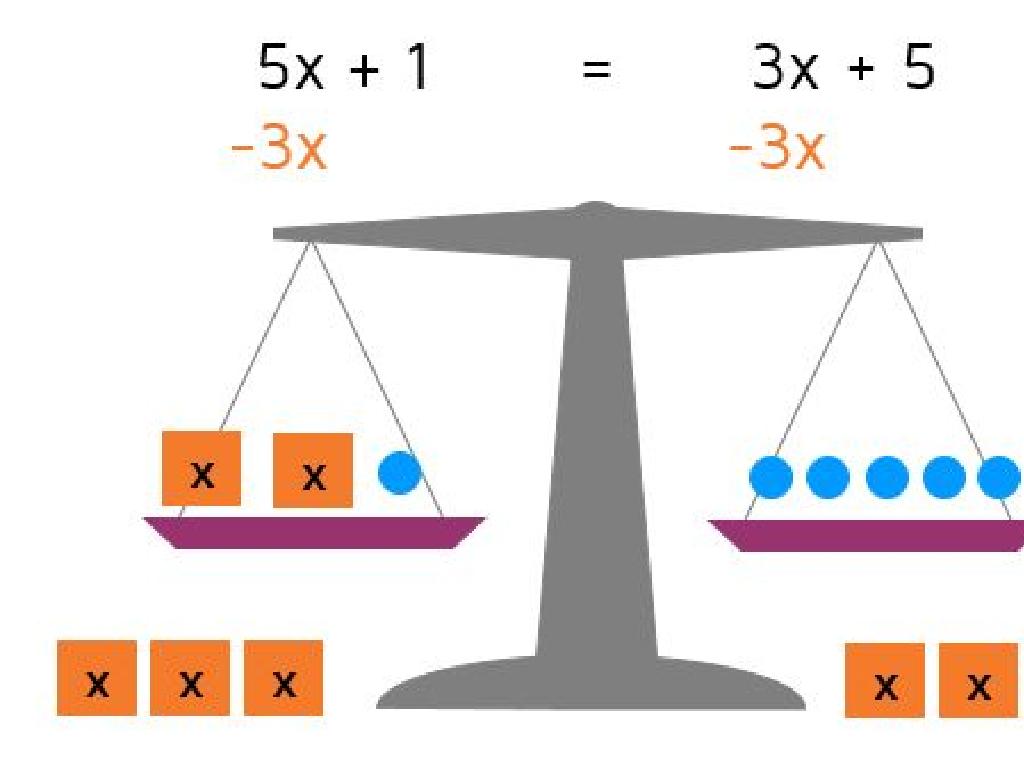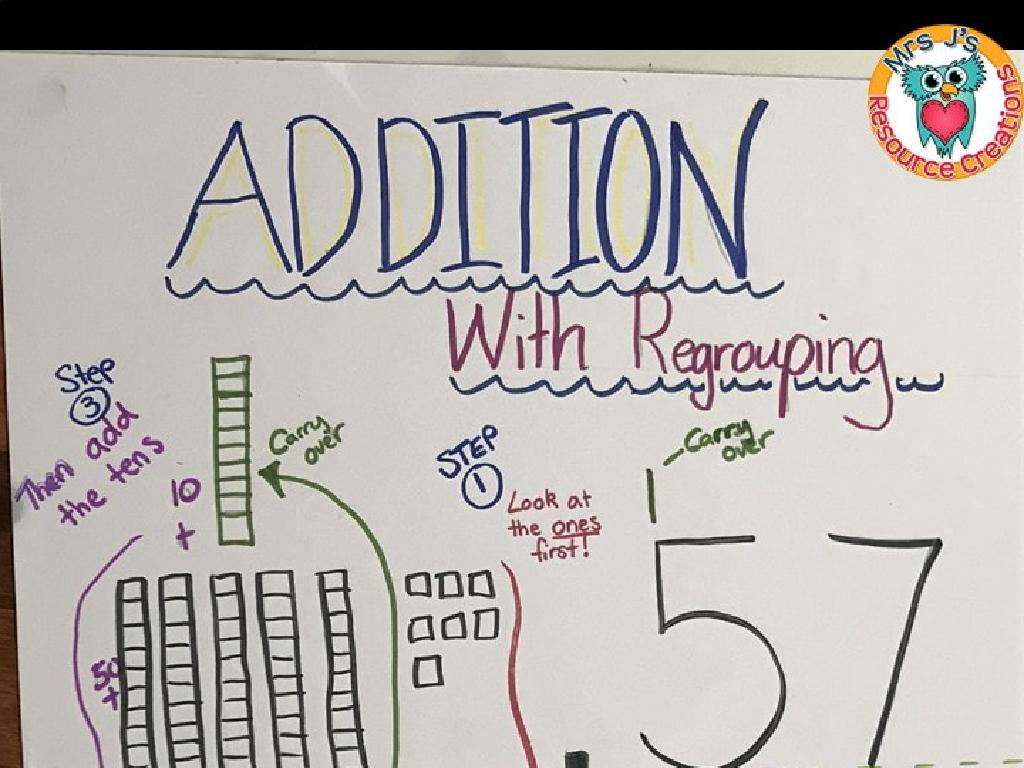Multiply And Divide Integers
Subject: Math
Grade: Eighth grade
Topic: Integers
Please LOG IN to download the presentation. Access is available to registered users only.
View More Content
Welcome to Integers: Multiplying and Dividing
– Introduce integers and their types
– Integers include whole numbers, zero, and negatives
– Explore positive and negative numbers
– Positive numbers are above zero, negatives below
– Apply integers to real-life scenarios
– Temperature changes, bank transactions, elevations
– Practice with multiplication and division
– Rules for multiplying/dividing positives and negatives
|
This slide introduces the concept of integers, which are the set of whole numbers including zero and negative numbers. Emphasize the difference between positive and negative numbers, and how they are used in everyday life, such as in temperature changes, bank account credits and debits, or measuring above and below sea level. Provide clear rules for multiplying and dividing integers, such as the fact that multiplying two integers with the same sign gives a positive product, while different signs give a negative product. Encourage students to think of additional real-life examples where they encounter integers. Prepare to engage the class with practice problems that reinforce these concepts.
Multiplying Integers
– Rules for multiplying integers
– Same signs multiply to positive, different signs to negative
– Multiplying positives and negatives
– Positive times negative gives a negative result
– Example: 3 x (-4)
– 3 x (-4) equals -12
– Practice problem set
|
This slide introduces the rules for multiplying integers, focusing on the concept that the product of two integers with the same sign is positive, while the product of two integers with different signs is negative. Use the example 3 x (-4) to illustrate how a positive number multiplied by a negative number results in a negative product. Encourage students to think of real-life scenarios where this applies, such as gaining and losing points in a game. Provide a set of practice problems for students to apply these rules and solidify their understanding of multiplying integers.
Multiplication Practice: Pair & Solve
– Pair up for multiplication problems
– Predict the sign of the product
– Is the product positive or negative?
– Calculate and confirm your answers
– Use integer rules to find the right sign
– Share methods with the class
– Discuss different solving strategies
|
This slide introduces a class activity focused on multiplying integers. Students will work in pairs to solve a set of multiplication problems, which encourages collaboration and peer learning. Before they start calculating, they should discuss and predict whether the product of the integers will be positive or negative, reinforcing the rules for multiplying integers. After solving the problems, students will confirm if their predictions were correct and then share their solutions and methods with the class. This activity aims to deepen their understanding of integer multiplication and to expose them to different problem-solving techniques. For the teacher: Prepare a diverse set of multiplication problems, ensure students understand the rules for determining the sign of the product, and facilitate the sharing session to include a variety of methods.
Dividing Integers
– Understand rules for division
– Same signs result in a positive, different signs result in a negative
– Dividing positive & negative numbers
– A positive divided by a negative gives a negative, and vice versa
– Work through an example
– Let’s solve (-12) ÷ 3 step by step
– Apply rules to solve (-12) ÷ 3
– Using the rules, (-12) ÷ 3 equals -4 because the signs are different
|
This slide introduces the rules for dividing integers, emphasizing the importance of the signs of the numbers involved. When dividing integers, if the signs are the same, the result is positive; if the signs are different, the result is negative. Provide the example (-12) ÷ 3 to illustrate how a negative number divided by a positive number results in a negative outcome. Encourage students to apply these rules to various examples to solidify their understanding. The example provided should be worked through as a class, with students encouraged to explain each step to ensure comprehension.
Division Practice: Dividing Integers
– Complete the individual worksheet
– Pay attention to the signs
– Remember: A positive divided by a negative, or vice versa, results in a negative
– Review answers collectively
– Clarify any doubts in class
– Ask questions if you’re unsure about the answers
|
This slide is for a class activity focused on practicing division with integers. Provide each student with a worksheet containing a variety of division problems involving integers. Remind students to carefully consider the signs of the numbers they are dividing, as this will determine the sign of their answer. After completing the worksheet, go through the answers as a class to ensure understanding and address any misconceptions. Encourage students to participate in the review and to ask questions about any steps they are unsure of. This activity will help solidify their understanding of the rules for dividing integers and prepare them for more complex mathematical concepts.
Multiplying and Dividing Integers in Word Problems
– Apply multiplication/division to solve
– Understand context for correct operation
– Example: Debt to four friends
– Owing $5 each, to 4 friends, represents a multiplication problem
– Calculate total debt owed
– Multiply the debt (-$5) by the number of friends (4) to find the total
|
This slide aims to help students apply their knowledge of multiplying and dividing integers to real-world scenarios. Students should learn to carefully read the problem, understand the context, and determine whether to multiply or divide. The example provided is a practical situation where multiplication is used to calculate total debt. It’s important to highlight that owing money is represented by negative numbers in mathematics. Encourage students to think of similar situations where they have to multiply or divide integers, and to practice setting up and solving these problems. This will enhance their problem-solving skills and their understanding of integers in everyday life.
Group Activity: Integer Operations
– Split into groups for challenges
– Solve and present integer problems
– Explain your group’s reasoning
– How did you arrive at the solution? Discuss within the group before presenting.
– Discuss various solving approaches
– Are there alternative methods? Share different strategies and correct misunderstandings.
|
This group activity is designed to foster collaborative learning and critical thinking as students tackle integer operation challenges. Divide the class into small groups and provide each with a set of problems involving multiplication and division of integers. After solving the problems, each group will present their solutions and explain the reasoning behind their answers. Encourage active discussion to explore different problem-solving approaches and address any misconceptions. This activity not only reinforces the mathematical concepts but also enhances communication and teamwork skills. Possible activities could include: creating a number line to visualize integer operations, using counters to represent positive and negative values, or developing real-life scenarios that involve integer calculations.
Review: Multiplying & Dividing Integers
– Summarize multiplication rules
– Multiply same signs for a positive, different signs for a negative result
– Summarize division rules
– Divide same signs for a positive, different signs for a negative result
– Significance of integer signs
– Understanding positive and negative signs is crucial for correct answers
– Quick quiz to reinforce concepts
|
As we wrap up today’s lesson, let’s review the key rules for multiplying and dividing integers. Remember, when multiplying or dividing integers with the same signs, the result is always positive, whereas with different signs, the result will be negative. Grasping the concept of signs is essential as it forms the basis for solving integer problems accurately. To ensure everyone is on the same page, we’ll end with a quick quiz. This will help solidify the day’s learning and identify any areas that may need further clarification. The quiz should include a variety of problems, some straightforward and others more complex, to challenge the students and encourage them to apply the rules they’ve learned.
Homework: Mastering Integer Operations
– Practice multiplying and dividing integers
– Solve the provided problem set to reinforce today’s lesson
– Preview: Adding & Subtracting Integers
– Get a head start on the next topic to stay ahead
– Ask questions anytime
– Don’t hesitate to reach out for help or clarification
– Stay prepared and confident
|
This slide outlines the homework assignment which aims to solidify the students’ understanding of multiplying and dividing integers. Provide a diverse set of problems to ensure students practice with different levels of difficulty. Introduce the concept of adding and subtracting integers to prepare them for the upcoming lesson. Encourage open communication and remind students that seeking clarification is part of the learning process. Ensure they understand the importance of consistent practice to build confidence in their mathematical abilities.






